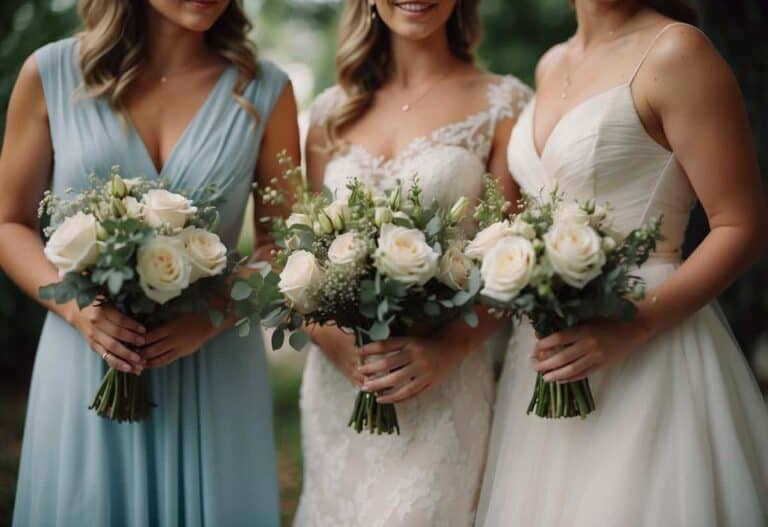DIY Wedding Bouquet Tips: Create Beautiful Bouquets on a Budget
Creating your own wedding bouquet can be a rewarding and personal experience. Whether you’re looking to save money or add a unique touch to your big day, a DIY bouquet allows you to express your individual style. Crafting a bouquet yourself gives you complete control over the choice of flowers, colors, and design. You don’t have to be a professional florist to make something beautiful that perfectly complements your wedding theme.

Embracing a DIY approach can also be a fun and creative activity leading up to your wedding. It can be a wonderful way to involve friends and family, making the process even more special. Plus, these personal touches make your wedding day even more memorable.
1) Choose Seasonal Flowers
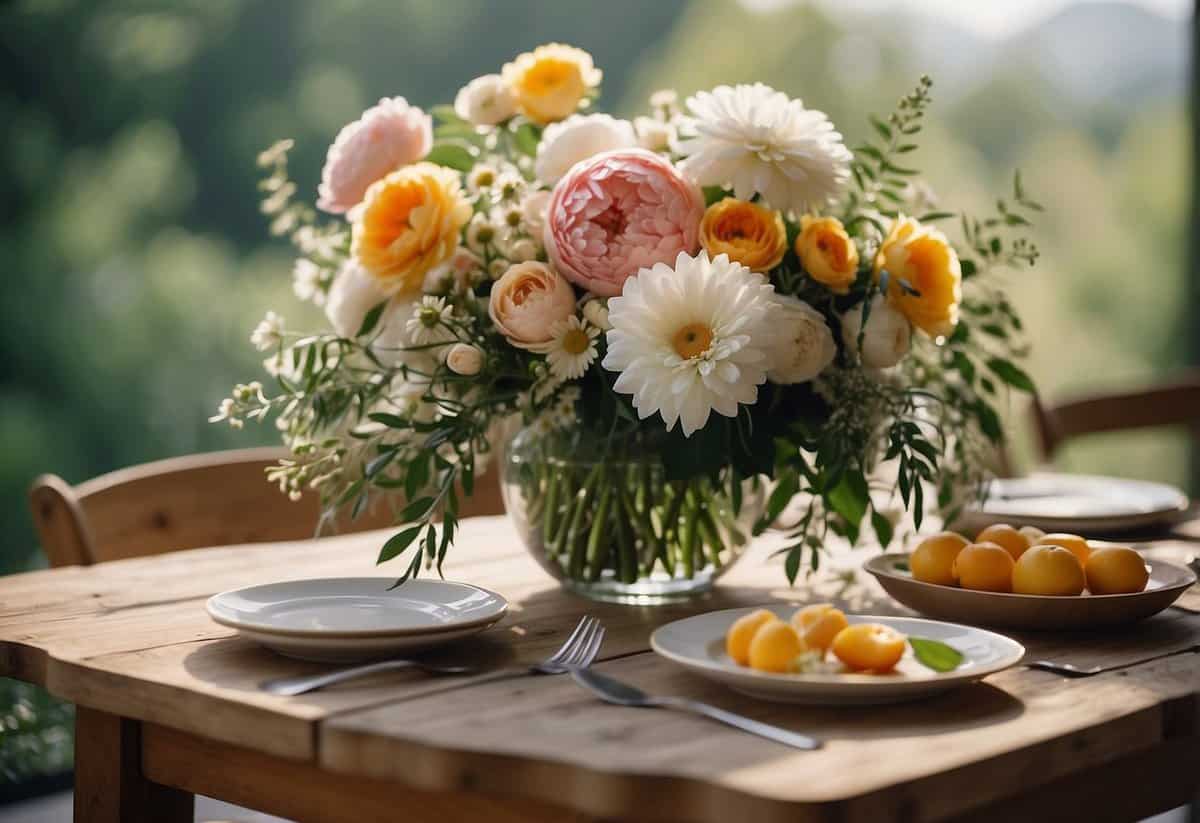
Choosing seasonal flowers for your wedding bouquet can save you time and money. Flowers in season are often more affordable and readily available.
Seasonal flowers also tend to be fresher and more vibrant. They are more likely to last longer on your big day and look their best.
Consider the colors and types of flowers that are in season around your wedding date. This can help you create a bouquet that fits the look and feel of your wedding perfectly.
Local flower shops and markets are great places to find seasonal blooms. They can often tell you what flowers are in season and help you make the best choices.
2) Mix Different Textures
When creating your DIY wedding bouquet, mixing different textures can add a lot of visual interest.
Start by selecting a variety of flowers with different shapes and sizes. This helps to create a dynamic look.
Don’t forget to include some greenery. Leaves and ferns can add a soft, flowing texture.
Adding some unique elements like berries or twigs can also make your bouquet stand out.
Using a mix of textures ensures that your bouquet isn’t too flat or boring. It makes every angle interesting.
3) Add Greenery for Depth
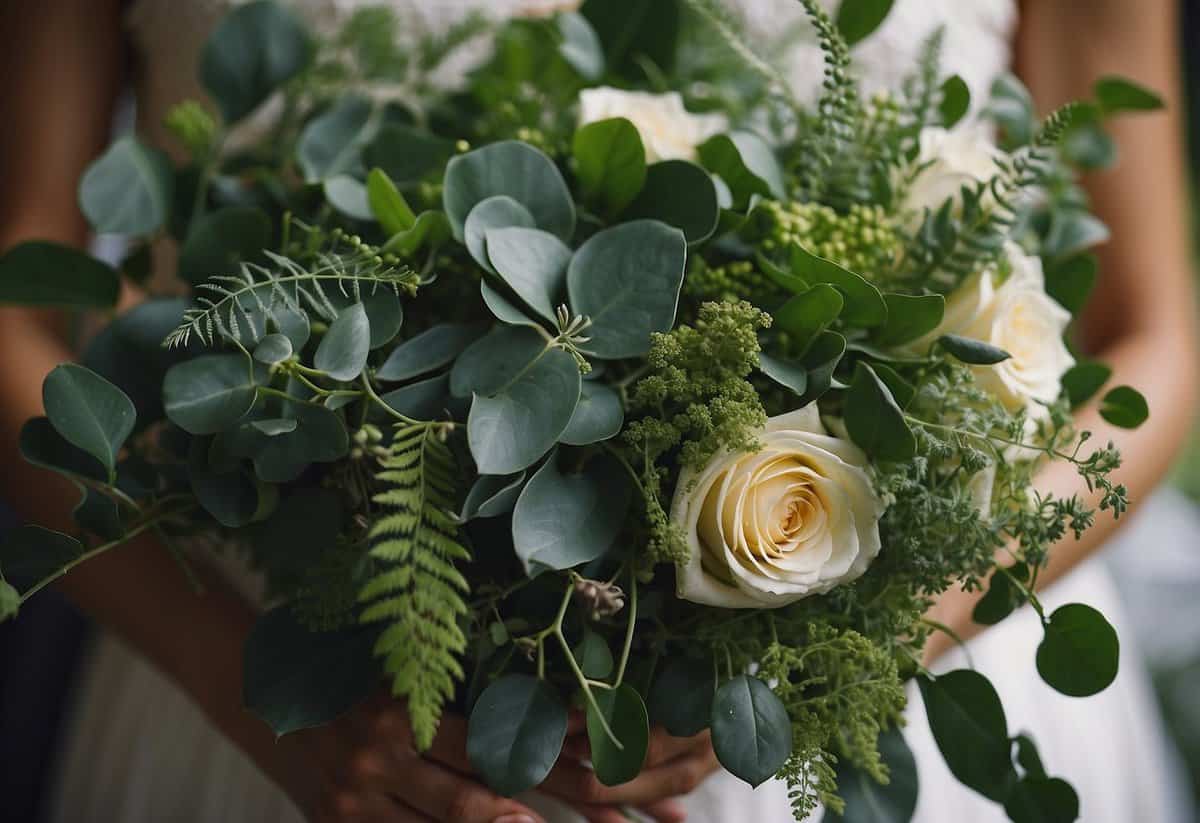
Using greenery in your bouquet can give it a richer and more natural look. Green plants, like eucalyptus or bay leaves, create texture and fullness.
Mix different types of greenery to add variety. Ferns, ivy, and herbs can offer interesting shapes and shades. This combination creates a balanced and beautiful appearance.
Greenery can also help lighten the bouquet visually, making it seem less dense or heavy. It’s a great way to make your flowers pop.
4) Use Floral Tape to Secure
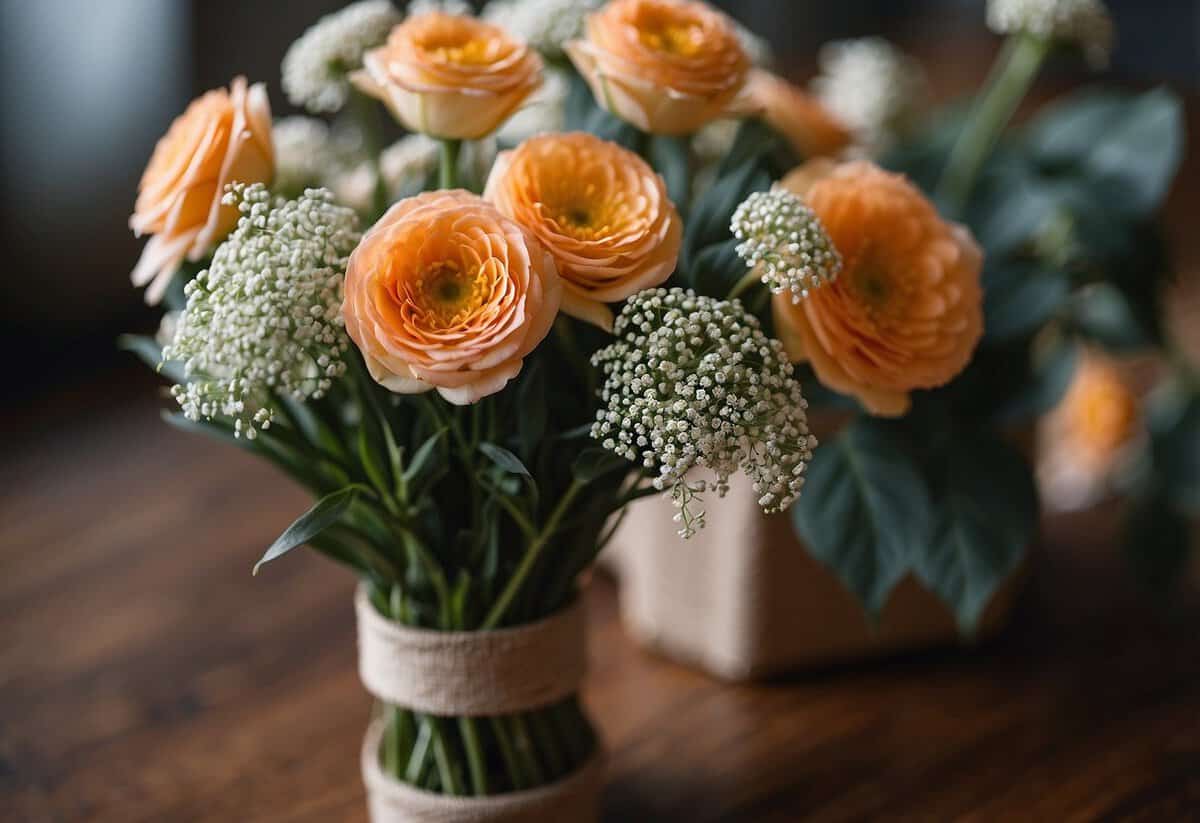
Floral tape is a must-have for making your wedding bouquet. This sticky yet stretchy material is ideal for holding flower stems together tightly.
Start by wrapping the tape around the base of your flower stems. Make sure to pull the tape as you wrap, so it sticks to itself and forms a strong bond.
Keep wrapping until you reach the end of the stems. Cut the tape and press it down firmly. This ensures your bouquet stays secure and looks neat on your big day.
5) Incorporate Personal Touches
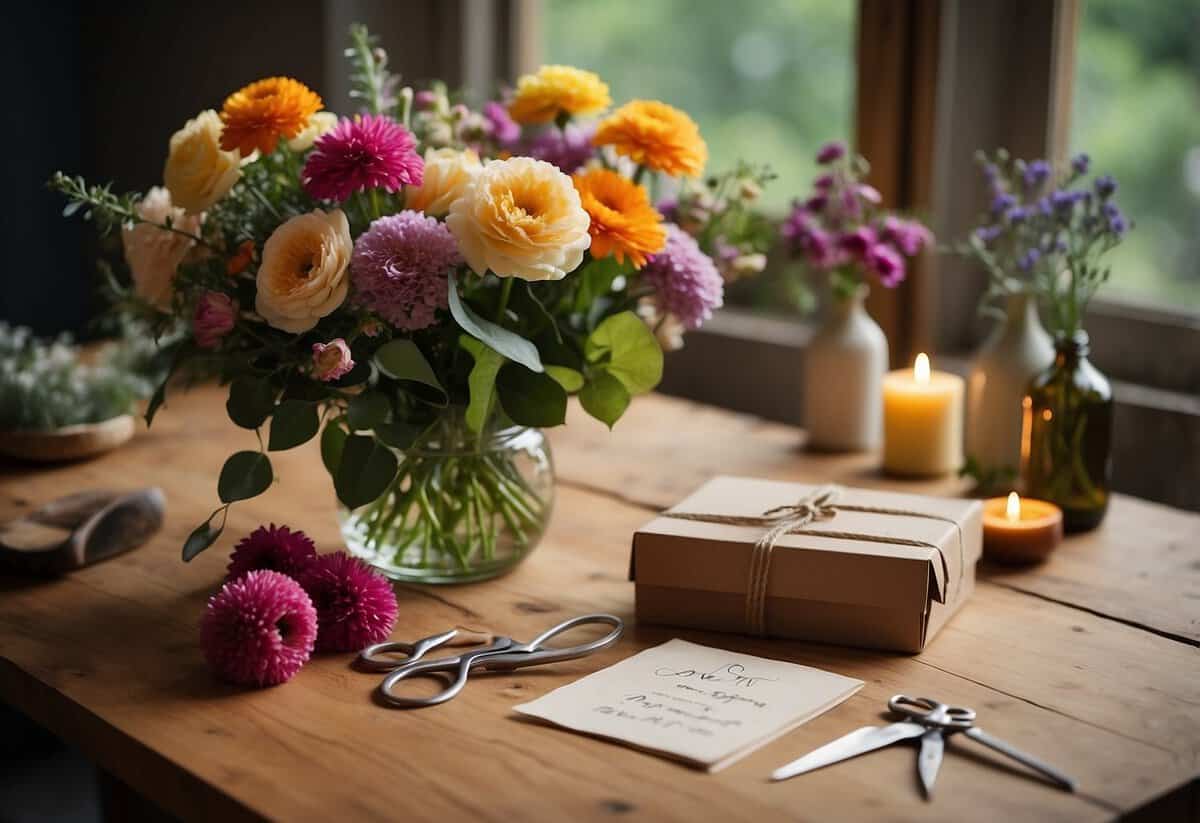
Adding personal touches to your wedding bouquet can make it even more special.
Consider including items that hold sentimental value. You could tie a ribbon from your mother’s wedding dress around the stems or add a charm that represents something meaningful to you both.
Using flowers from a family garden or choosing blooms that have special significance in your relationship is another great idea.
Don’t limit yourself to just flowers. Adding lace, fabric, or even small photos can bring a unique and memorable twist to your bouquet.
Charms, such as a locket with photos of loved ones, can also be a beautiful addition. These small details can make your bouquet a true reflection of your love story.
6) Select a Variety of Colors
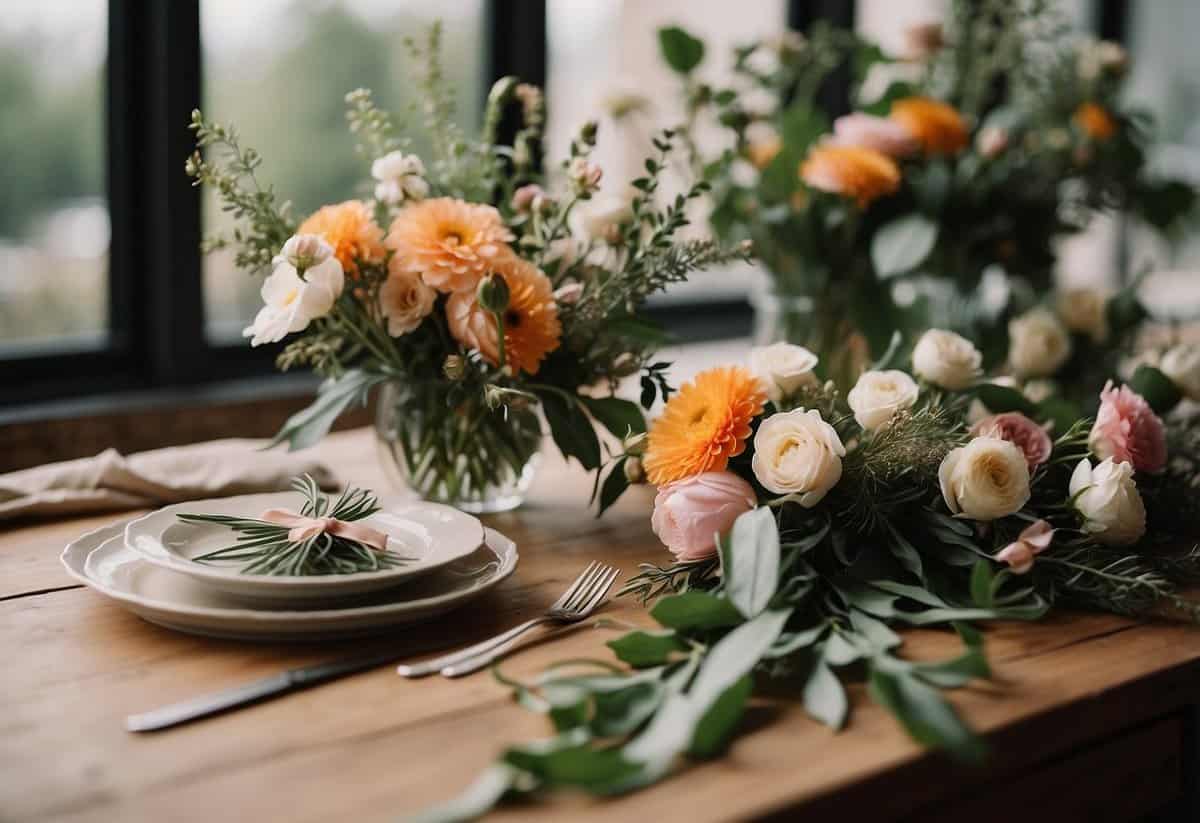
Choosing a range of colors for your wedding bouquet can make it stand out. Think about the theme of your wedding. Soft pastels can give a romantic feel. Bright, bold hues can add a pop of excitement.
You might want to mix different shades of the same color. This can create depth without being too busy. For example, combining light pink, medium pink, and dark pink flowers.
Don’t be afraid to mix different colors, too. Contrast can be beautiful. White flowers mixed with deep red or blue flowers can look very elegant.
Greenery can add a natural touch. Leaves and stems in different shades of green can break up the colors of the flowers. This gives your bouquet more texture and interest.
Remember to balance colors carefully. Too many can look chaotic. A mix of three to five colors usually works well. Keep your choices simple, yet stylish.
7) Consider Flower Size and Shape
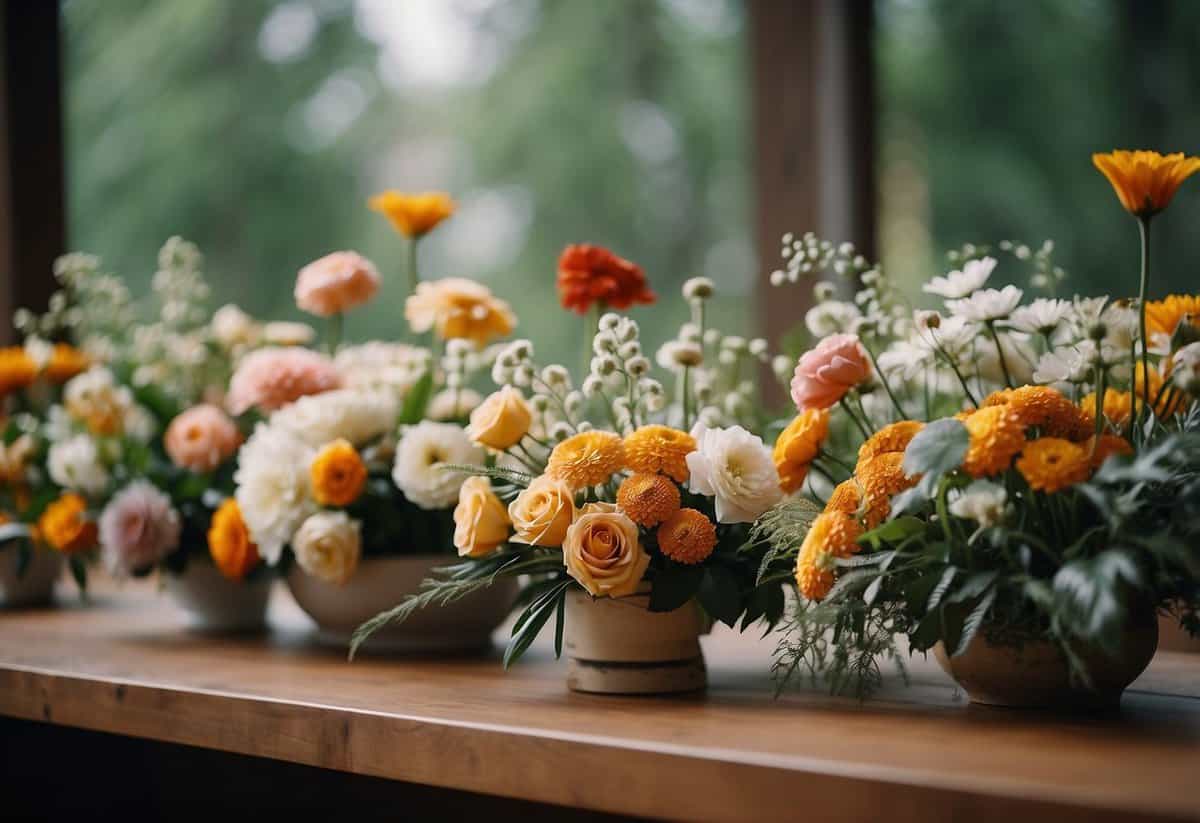
When making your bouquet, choose flowers of different sizes and shapes. This makes the bouquet look more interesting and balanced.
Large flowers like peonies or roses can be the main attraction. Pair these with smaller flowers like baby’s breath or lavender to fill in gaps.
Think about the shapes, too. Round flowers mix well with spikey or unique-shaped flowers. This variety adds texture and depth to your bouquet.
8) Use a Floral Foam Holder
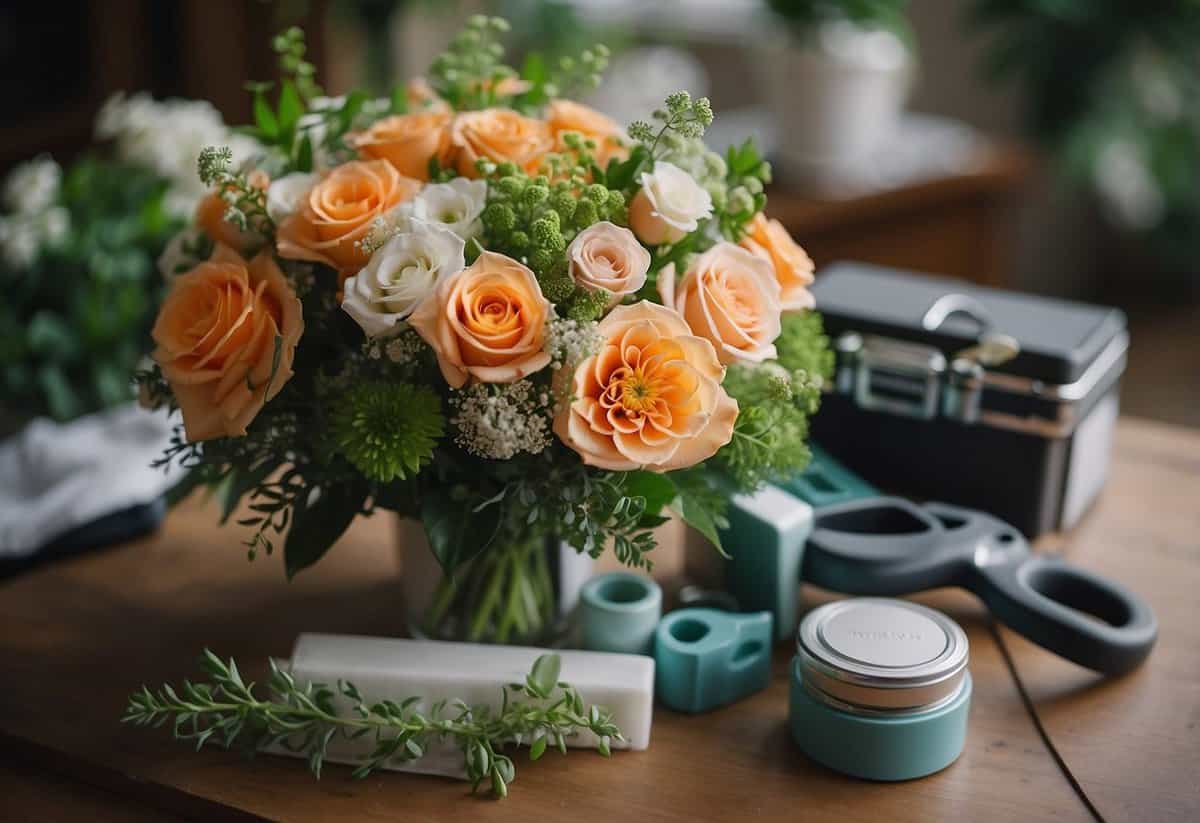
A floral foam holder is a great tool for making wedding bouquets.
Start by soaking the floral foam in water until it’s fully wet. This helps keep your flowers hydrated.
Next, place the bouquet holder in water until no more bubbles appear. Dry off the handle before using it.
Arrange your flowers by inserting stems into the foam. Use floral adhesive to keep them in place. This helps your bouquet stay secure and neat.
Fill in any gaps with smaller flowers or greenery. Enjoy creating a beautiful, long-lasting bouquet!
9) Include a Sentimental Keepsake

Adding a sentimental keepsake to your wedding bouquet can make it extra special. You might include a piece of jewelry, a locket with a photo, or a small memento that has personal meaning.
This keepsake can be attached to the bouquet with a piece of ribbon or floral wire to ensure it stays secure. By doing this, you carry a piece of your loved ones or cherished memories with you down the aisle.
It’s a lovely way to honor family traditions or personal connections. Including something meaningful is a beautiful touch that adds emotional value to your bouquet.
10) Balance the Bouquet Symmetry
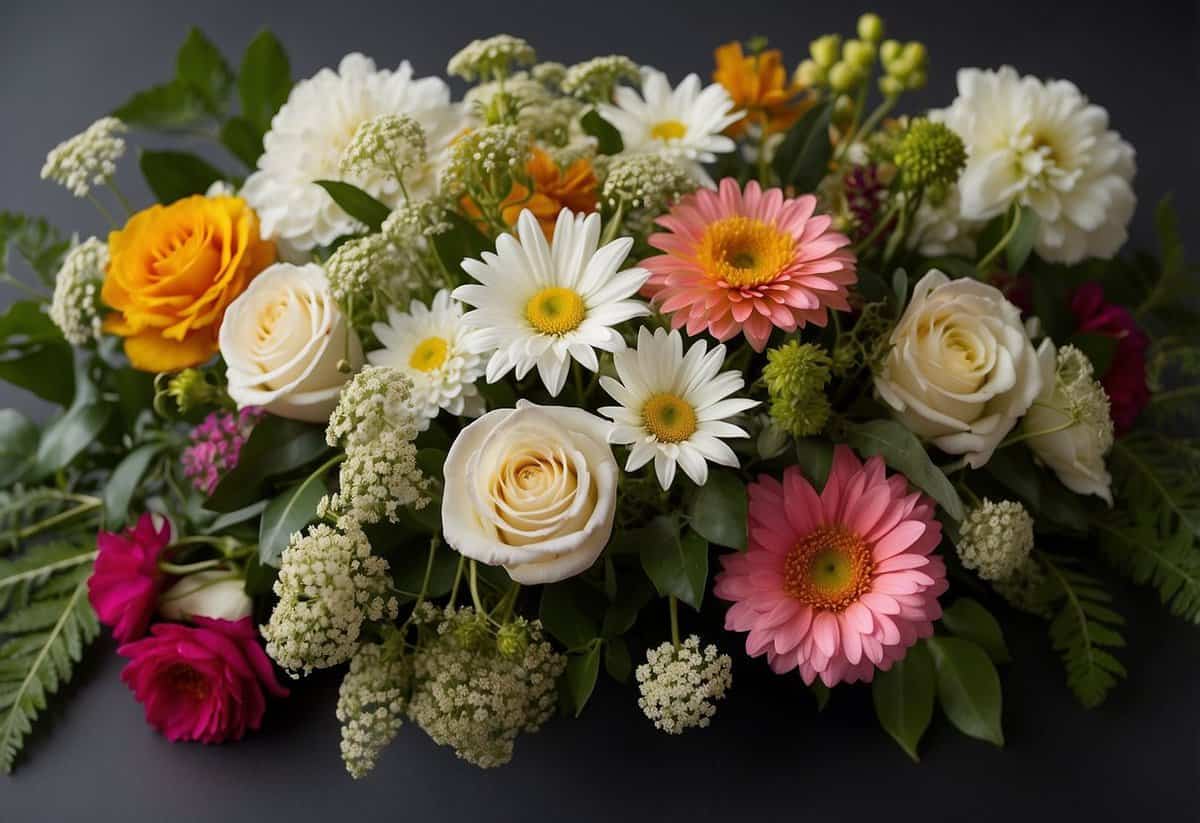
Balancing the symmetry of your bouquet is key to creating a stunning look. Start by selecting a central flower and build around it. This flower will act as the focal point.
As you add more flowers, make sure they are evenly spaced. Rotate the bouquet as you work to keep it balanced from every angle.
Use smaller blooms and fillers to fill in any gaps. Distribute them evenly throughout your arrangement. This helps maintain a cohesive appearance.
Finally, keep an eye on the greenery. Evenly spread out leaves and branches to add texture and volume without disrupting the overall symmetry of your bouquet.
Following these tips will help you create a balanced and beautiful wedding bouquet that complements your special day perfectly.
Choosing The Right Flowers
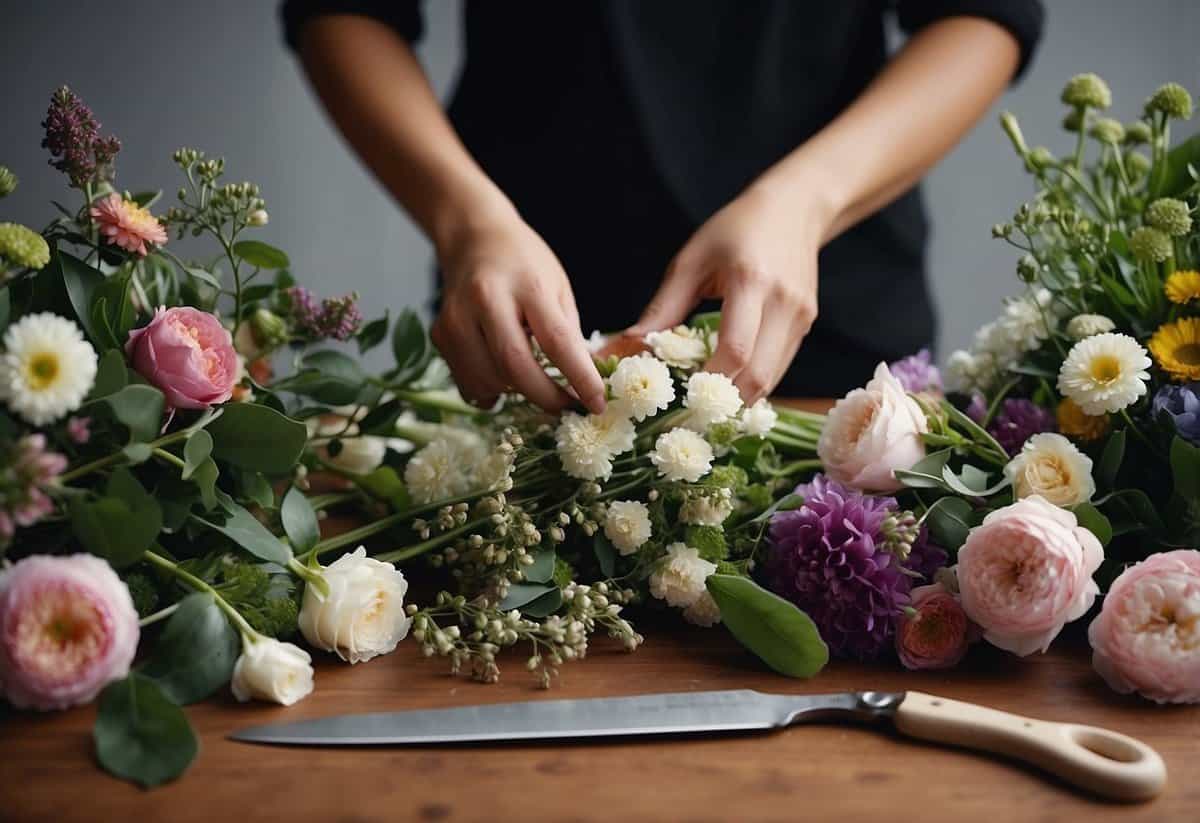
Choosing the right flowers for your wedding bouquet involves considering factors like seasonality and color coordination. This ensures that your bouquet is both beautiful and cohesive.
Seasonal Flower Selection
Choosing flowers that are in season helps ensure availability and can save on costs. Spring is great for tulips, daffodils, and peonies. Summer offers roses, sunflowers, and lilies. In fall, look for dahlias, chrysanthemums, and asters. For winter weddings, consider holly, camellias, and amaryllis.
Selecting seasonal flowers supports local growers and often results in fresher, more vibrant blooms. They are typically more robust and better suited to the prevailing weather, which can help your bouquet last longer.
Color Coordination Tips
Choosing colors that match your wedding theme is key. Start with a color palette that complements your overall wedding colors. For example, if your wedding color is blush pink, consider pairing it with whites, greens, and soft purples.
Complementary colors, like yellow and purple, can make your bouquet pop, while analogous colors, like blue and green, create a more harmonious look. You can use a color wheel to help find the best combinations.
Balancing bold and neutral colors is also important. Incorporate greenery to add depth and avoid overwhelming the bouquet with too many bright flowers. This helps create a balanced, visually pleasing bouquet that ties in well with your wedding theme.
Prepping And Assembling Your Bouquet
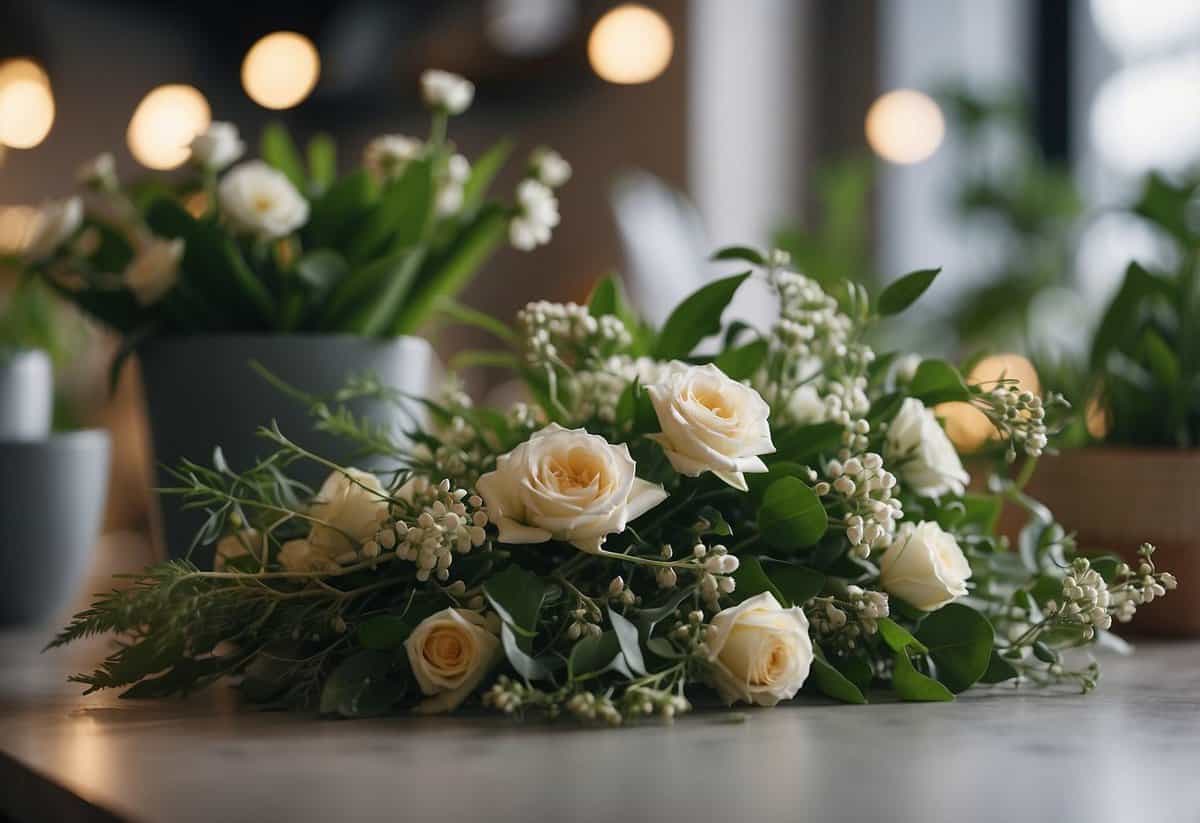
Getting ready for your wedding bouquet involves some smart choices with stems and arranging techniques. Let’s go through how to trim and condition stems, and discover some thoughtful arranging methods.
Trimming And Conditioning Stems
First, make sure your flowers are fresh. To condition your stems, cut them at a 45-degree angle under running water. This angle helps them absorb water better. Use sharp, clean scissors or pruning shears.
Remove any leaves that will fall below the waterline in your vase. Leaves in water can lead to bacteria growth, which shortens the life of your bouquet. Then, place the stems in a clean container filled with room temperature water.
Let your flowers sit in water for a few hours, ideally overnight, before arranging. This step ensures they are well-hydrated. For an extra boost, add flower food to the water.
Arranging Techniques
Start by choosing a focal flower—this will be the center of attention. Popular choices are roses or peonies. Add other flowers around it, rotating the bouquet in your hand to keep it balanced.
To create depth, mix in different shapes and sizes of flowers. Use greenery like eucalyptus or ferns to add texture. Keep adding stems, spacing them evenly.
When your bouquet looks full, wrap the stems tightly with floral tape. This keeps them secure. Then, wrap ribbon around the stems for a polished look. Finish with a knot or bow at the base.
These steps will help you create a beautiful, long-lasting bouquet for your special day.
Maintaining Freshness
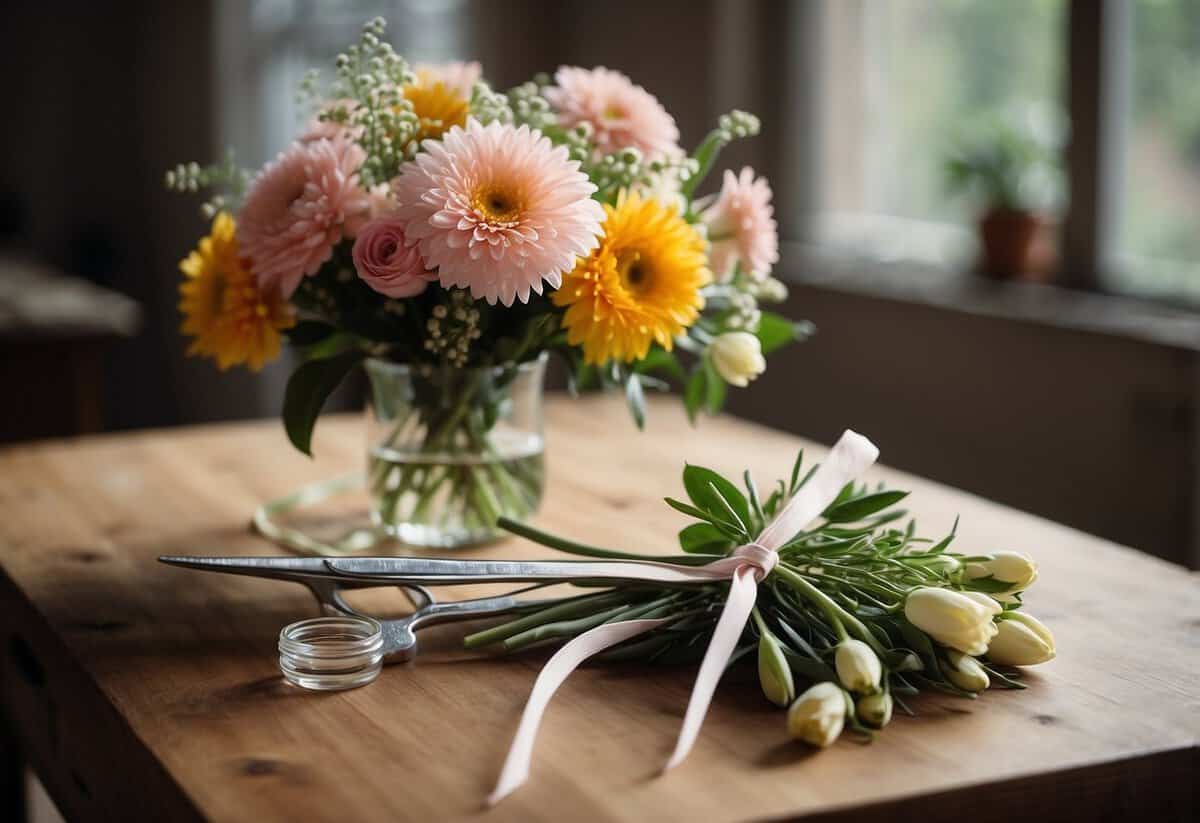
Keeping your wedding bouquet fresh is key to making it last. Proper watering, preservation, and storage methods will help you enjoy your flowers longer.
Watering And Preservation
Hydration is crucial for maintaining the freshness of your bouquet. Immediately after the ceremony, place your bouquet in a vase with clean water. Trim the stems at a 45-degree angle to improve water absorption.
Tip: Avoid direct sunlight and heat as it causes wilting. Keep your bouquet in a shaded and cool area. Refrigerating your bouquet overnight at 36-38°F can prolong its life. Note: Keep it away from fruits and vegetables in the fridge since they emit ethylene gas, which can cause wilting.
If you’re using preservation methods like glycerin, this replaces the water in the flowers, keeping them looking fresh. Make sure to follow detailed guides for each type of preservation process.
Storage Recommendations
Proper storage helps keep your bouquet vibrant before you preserve it. Store your bouquet in a cool, shaded area. Avoid any place with extreme temperatures, as heat can cause the flowers to wilt quickly.
Important: Store flowers away from direct sunlight. Sunlight and heat can quickly dry out petals, making them less vibrant.
When storing in a fridge, ensure the temperature is consistent. Use a designated drawer or shelf to avoid crowding and potential damage. Handle your bouquet gently to prevent bruising the flowers.
Always make sure your bouquet is properly hydrated before storing. Using absorbent paper can help manage excess moisture while keeping your flowers fresh.





